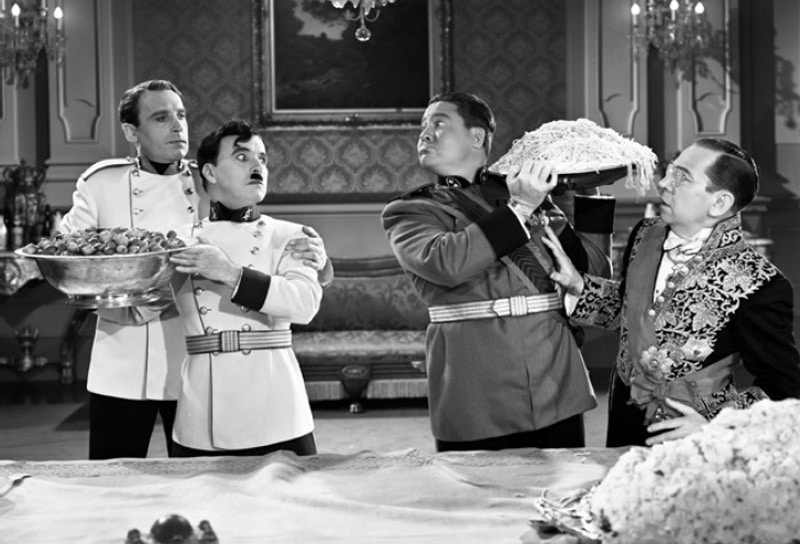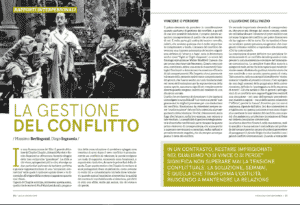
MANAGEMENT OF EMOTIONS: DISGUST
7 March 2020
Smart Working
9 March 2020Article by Diego Ingrassia and Massimo Berlingozzi – “INTERPERSONAL RELATIONS: THE MANAGEMENT OF CONFLICT”
for PSICOLOGIA CONTEMPORANEA – Creativity – no. 274, July-August 2019 – GIUNTI EDITORE
In a famous scene from the film The Great Dictator by Charlie Chaplin, Adenoid Hynkel and Bonito Napoloni confront each other, showing off their mutual ‘greatness’.
The challenge to see who wins, pushing themselves higher, takes place on two particular barber’s chairs: a perfect and ingenious representation of a ‘symmetrical escalation’ in which the one-up/one-down roles and the dynamics at the origin of the contention appear as clear as ever.
Chaplin’s genius anticipates, through this scene, what Paul Watzlawick’s theories on the pragmatics of communication would explain to us some thirty years later:true conflict is primarily a conflict of relationships, words play a supporting role, rarely functional, and above all decisive, during the early stages of the dispute.
This is why Chaplin makes his protagonists recite stupid phrases, as is the case in many quarrels we witness on TV talk shows: when the symmetrical escalation is triggered, the quality of the content inevitably deteriorates, because there is a much older challenge between who wins and who loses.
WIN OR LOSE.
The first element to take into consideration when we talk about conflict management, and thus their possible resolution, is precisely this: becoming aware of what is going on inside us. It is in the oldest part of our brain, in fact, that something happens that is very important to understand thoroughly.
The triggering of conflict determines an automatic response of our organism defined as ‘attack or flight’, also known in literature as ‘fight or flight response’, in honour of the American physiologist Walter Bradford Cannon who first described this phenomenon.
This mechanism, as we know, activates a series of physiological changes aimed at determining the maximum effectiveness of such behaviour.
But the aspect we wish to emphasise here is how such behaviours, which have played a fundamental role in the course of evolution for the survival of our species, take on completely different meanings when placed in the context of a social dynamic.
What we will try to show is that getting involved in a ‘win or lose’ challenge never generates the best premises for conflict resolution. Resolution always to be understood as a ‘transformation’ of the conflict oriented towards the continuation of the relationship.
Because, clearly, both flight and attack, in their essence, do not aim at such an outcome.
The possibility of strategically managing conflict dynamics thus starts from this first element of awareness, which also helps to overcome deeply rooted and predominantly negative beliefs and stereotypes that have always accompanied the topic of conflict.
The ILLUSION OF THE BEGINNING
A second important element of awareness, which diverges even more from common sense, consists in abandoning the illusion that we can establish with certainty the origin of the conflict, in order to prove who is right and who is wrong.
Since childhood, we have been inculcated with this thought, both parents and teachers inducing us to answer the question: “Who started it?”.
The belief that we can precisely define the initial event of a conflict falls away when we understand the systemic and circular nature of communicative interaction.
The simple phrase “It is not me who is explaining myself wrongly, it is you who do not understand” can evidently be overturned by any interlocutor who does not share or accept this point of view.
This concept, in its simplicity truly ‘revolutionary’ with respect to common thinking, is well explained by one of the axioms of communication pragmatics, called the ‘punctuation of the sequence of events’.
What happens is that usually the protagonists of a conflict do not deny the objective reality of a situation – in the case of the previous example: not being able to understand each other – but only define the ‘effect’, because the ’cause’, the reason why they do not understand each other, depends on the other.
If the two disputants stiffen on this position, and are unwilling to change their view of the conflict, there can only be a further input of force into the system (symmetrical escalation). The pattern described so far is, in its essence, very simple and its nature is so deeply rooted in human behaviour that we can compare the small quarrel between two children with major international conflicts.
When in the days of the Cold War there was talk of an arms race, neither of the two disputants, the US and the USSR, denied the objective reality of the situation; in fact, when asked, they would reply: ‘It is true that we are increasing our armaments, but we are only doing so for defensive reasons (the effect) because the others have taken up threatening and offensive positions (the cause) to which we are forced to respond.
In short, in both small disputes and big conflicts, we are faced with an awareness deficit due to the difficulty of accepting the undoubtedly complex, and in some ways counter-intuitive, nature of communication; the latter, precisely in conflict, reveals more explicitly than ever its systemic (circular and recursive) nature, which leads, through the concept of feedback, to overcome the linear cause-effect vision, to arrive at a scenario in which the people involved are united by a particular bond: they influence and depend on each other at the same time.
The BOND OF INTERDEPENDENCE.
This particular bond, or bond of interdependence, becomes inevitable when the protagonists in a dispute, however conflicting, do not escape the relationship, and we can express it in the following terms: the bond between the parties is such that the objective of each party can only be achieved through the other.
This is what happens in negotiations, in which none of the parties involved has all the power, and the action of each party influences and depends on the action of the other. Therefore, we can consider this particular condition, the ‘method of negotiation’, when formally accepted, as one of the highest achievements of our civilisation.
Indeed, the negotiator decides to ‘abandon arms’ and sit around a table to discuss, trusting that a solution will be found. To say this is certainly not to underestimate the inherent difficulty of the method.
For millennia, human beings have resolved their conflicts (and continue to do so) through struggle, physical confrontation, war, accepting to submit, to depend, only when defeated.
For our mind, therefore, it is extremely difficult to make these two forms of relationship coexist within the same situation: affirm and concede; convince and accept; influence and depend.
The awareness of this limitation of human nature was very clear to a brilliant pedagogue, Loris Malaguzzi, the creator in the 1960s of a model of infant schools that became well known even abroad under the name of the ‘Reggio Emilia approach’.
To deal with this difficulty, he had devised a very effective game: he spread a large sheet of paper containing the outline of an animal on the floor and asked the children to trace the edge of that outline with a coloured pencil at their disposal.
Each child’s pencil was, however, tied to the pencils of all the others by a dense web of thin strings.
Each individual child then realised that at certain stages he could move forward and that at other times it was necessary to stop for someone else to move forward, until, with the tension of the string diminished, he could push his own pencil forward again.
So, no cognitive processing was necessary, the children experienced directly on their bodies, physically, this strange oxymoron: in order to move forward you have to stop.
The most important aspect in resolving conflicts, in transforming them into a dimension that is perhaps painful, but intentionally constructive, is therefore represented by a profound awareness of the relational dynamic that characterises them.
The next step imposes two precise choices: to oppose the logic of ‘either you win or you lose’, which risks dragging us into a regressive spiral (attack/flight), and to abandon the idea of being able to gain an advantage by establishing the original cause of the conflict, because within any ongoing relationship anyone is always able to draw on a ‘before’ and, when this is not possible – as has really happened in many human affairs – to invent it.
EMOTION MANAGEMENT.
What has been analysed so far has been helpful in understanding the fundamental importance of awareness for the effective management of conflict situations.
However, even the best awareness cannot escape the emotional stress that can result from a conflict dynamic.
The subject is extremely vast, so we will limit ourselves to outlining the most relevant guidelines.
Years of research on stress converge on one important point: it is not possible to establish an objective criterion for assessing the stressful potential of a certain environmental stimulus.
Emotional stress, therefore, even within a conflict dynamic, does not depend so much on what happens or what we do, but on how we interpret it.
And it is precisely on this point that we need to reflect, because it allows us to identify both the origin of the problem and possible solutions.
Almost always our inability to act flexibly within a conflict depends on a lack of awareness of our emotional dynamics and their consequences. Limits that manifest themselves in the difficulty of establishing positive relationships and in a lack of ability to manage emotions such as, for example, anger, fear or contempt for what is perceived as different or distant from oneself.
Recognising the factors triggering the emotion (trigger) one is experiencing helps us to identify a better strategy than habitual, unconscious behaviour. In this way, we can prepare ourselves to better manage our emotional reactions to great advantage also within the relational dynamic.
A simple technique, which can be of help in developing better emotional competence, is to draw up a list of all the situations in which a certain emotion got the upper hand, through a blocking mechanism that prevented us from acting effectively.
The next step is to try to match, to those specific situations, the factor (trigger) that triggered our blocking reaction.
Experience has taught us that if we can draw up a list of at least a dozen situations, we will realise that the triggers can generally be grouped into a couple of rather similar categories.
Understanding the origin of our emotions, being aware of our triggers, is a fundamental element in improving our ability to manage the emotional component within conflict situations.




